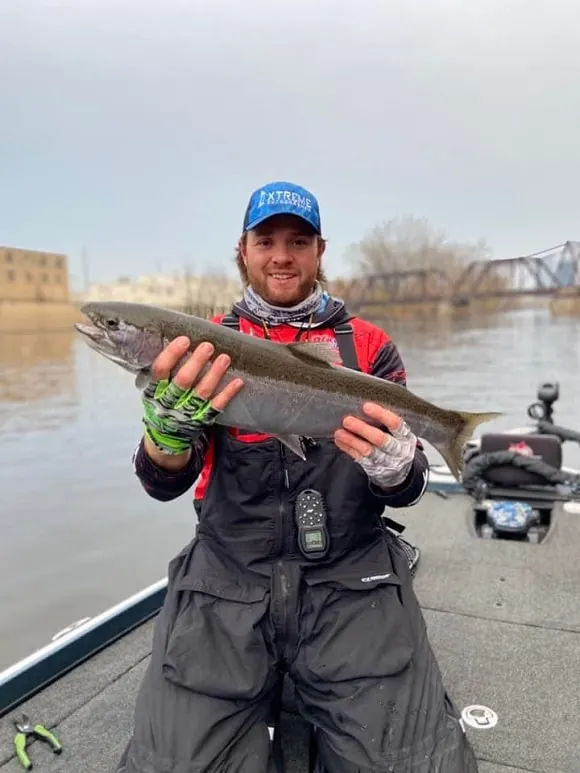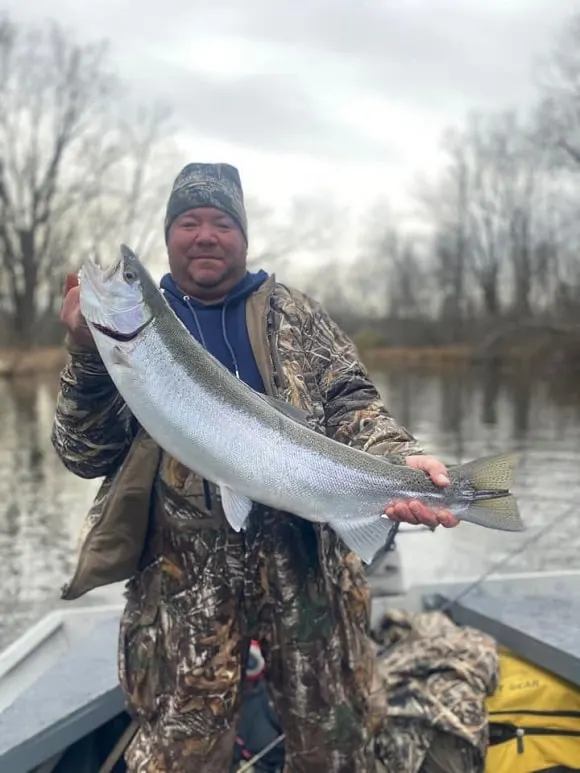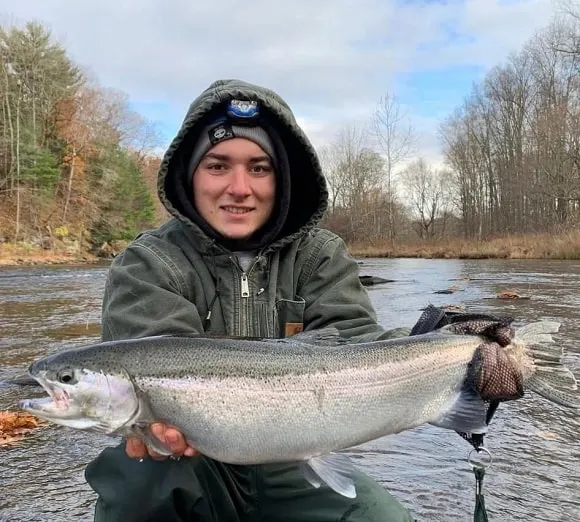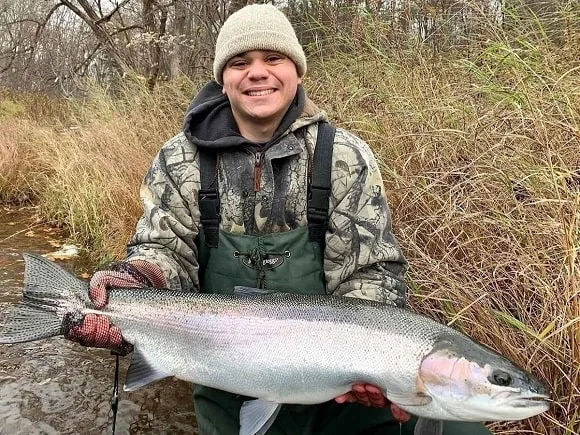Fishing for steelhead can be extremely fun or extremely frustrating. Seeing that river full of fish and not managing to get even a single bite isn’t something you want to experience.
And while blanking is always a risk when targeting steelhead, fishing during the right weather conditions can significantly increase your chances of hooking up.
The best weather for steelhead fishing includes stable temperatures and barometric pressure, an overcast sky, and a light drizzle. These often warmer weather fronts can really turn the fish on and give you plenty of action.
Keep reading this article to learn more about the optimal weather conditions for steelhead fishing and what weather tends to turn them off completely.
PRO TIP: Need to gear up for your next steelhead adventure? Then check out this quality equipment on Amazon. It’s very cost-effective, durable, and will get the job done every time!
What Are the Best Weather Conditions for Steelhead?

Steelhead tend to turn on after a few days of stable conditions, and while both stable warm and cold fronts can be favorable, warm fronts usually take home the prize.
That’s because warm weather fronts almost always bring the following conditions with them:
- steadily rising temperatures
- falling barometric pressure or stable low pressure
- overcast skies
- humidity, drizzles, or light to moderate rain
- southern or western winds
I’ve discussed warm fronts and low-pressure systems in other species articles, and based on my own and others’ experiences, I’ve always come to the same conclusion: fish love them!
It’s like someone pushing a button, turning on the fish’s activity and appetite. And the more stable and long-lasting such fronts are, the better the fishing tends to be!
That seems to hold true for migrating fish in river systems especially! And why not!
A river’s water level, current, and turbidity are all highly dependent on weather conditions, and if you’re a river angler yourself, you know how quickly things can change!
Those sudden changes would affect anyone’s mood and appetite, right?
And so, if there is warmer weather coming in and conditions both under and above the surface are relatively stable, steelies will turn on. It’s (often) really as simple as that! (But then again, when it comes to fishing, nothing is ever really that easy, is it!?)
And, as previously mentioned, that goes for cold fronts as well. You can expect to get bites as long as there is a few days of stable cold weather.
Personally, I’d still always prefer warm fronts and low-pressure systems.
As an angler, it just feels “more right” to me, you know! And, if I am heading out in the middle of winter, milder weather is just always nicer to fish in than biting cold weather!
This brings us to another essential aspect of steelhead fishing, water temperature.
What Are the Optimal Water Temperatures for Steelhead Fishing?

As long as the water has a temperature between 40 to 55F, steelhead will remain very active and hungry.
On the other hand, their activity will decrease drastically in water temperatures below 35F, and water temperatures above 60F or so will set off the spawn.
Of course, this temperature range will vary geographically, but generally speaking, a range between 40 to mid-50 is a solid one to target steelhead in!
Many rivers will have such temperatures well into late fall and then again from late winter to mid-spring (once again, the geographical variations will have to be considered here).
However, this does not mean that you should be targeting them in colder water temperatures below 40F!
On the contrary! If you happen to time one of those warm fronts during winter, you could very well end up experiencing a real mid-winter feeding frenzy!
Due to their low activity in the cold water, the fish are hungry and low on energy, and after a few days of that warm front changing up things in the air and water, it’ll often be their time to strike.
And if you don’t have the luxury to time in those warm fronts, you can still have productive days, even in very cold water!
Just try to stick to deeper stretches of the river and the deep pools and backwaters. These areas will hold somewhat warmer water on the bottom and it’s usually here you can find those coldwater steelhead!
Is Rain Good for Steelhead Fishing?

While rain is necessary at the very beginning of the steelhead runs, as it raises the rivers’ water levels and makes migrating upstream easier for the fish, too much rain during the season can be pretty disadvantageous for the angler.
Especially during the colder months of the year, heavy rainfalls usually mean plenty of mud and dirt that gets washed into the river system.
This, in turn, will stain the water, and that, dear reader, is something that’s generally to be avoided when steelhead fishing.
In fact, I’ve heard from many anglers that muddy water conditions basically make catching steelhead an absolute impossibility.
Trout and salmon are salmonids, which thrive in clear water conditions. Stained water, especially the running kind, tends to turn them off completely.
To understand why all you have to do is consider the baits and lures you’re using when steelhead fishing!
Almost all steelhead are caught on wither flies and streamers or natural or artificial salmon eggs.
And what do they have in common? They’re very small and hard to spot in muddy water! It makes a lot of sense, doesn’t it!
PRO TIP: Wait out the rain and give it a few days before heading out to the river again! Visibility underwater will now have improved considerably and the river’s water level will still be elevated, offering you optimal conditions for post-rain steelies! Heavy rain’s terrible, but the days after those rainfalls can turn the river into a steelhead paradise!
Worst Weather Conditions for Steelhead Fishing
Of course, when we talk about the best weather conditions, the worst should also be mentioned in this article!
I think we can all agree that cold temperatures and icy northern or eastern winds are never really favorable for fishing (or us anglers).
But as mentioned above, stable cold fronts with cool air, high pressure, and sunshine can actually produce fairly well on certain days too!
What doesn’t sit well with the steelhead are sudden weather changes. Whether it’s from cold to warm, overcast to clear sky, calm winds to storms, or high to low pressure, it’ll almost always turn the bite off if things move too quickly.
Additionally, really icy conditions that will force water temperatures to plummet can make things pretty tricky.
The fish will adapt their body temperature and feeding activity to the surrounding temperatures, and if the water gets too cold, they will simply stop feeding altogether.
Best Steelhead Fishing Destinations in the US

If you’d like to read up on some of America’s very best steelhead fishing destinations, you can check out the following state guides that I have recently written.
They contain detailed state-specific information on the best steelhead rivers, seasons, and fishing charters, as well as helpful information on regulations and licenses:
Final Thoughts
So there you go. You now know the best and worst weather conditions for steelhead fishing!
But you know what, I would be lying if I said that this is 100% accurate for all rivers and regions in the world. I mean, it’s fishing, and nothing about fishing will ever be 100% certain!
While the weather conditions outlined in this article indeed work on many rivers and have been confirmed by many steelheaders, you should, nevertheless, only regard them as general guidelines and pointers.
Rivers and fish stocks vary, and what works on 99 rivers might not work on the 100th or the other way round!
What I always suggest to my readers is this: take the info of this article and use it as a starting point. If it works out, great, I’ve successfully saved you time and energy that you’d have spent gathering experience and data yourself. That’s always been my main goal with Strike&Catch.
But if things don’t work out, it’s probably not because the entire article was wrong or because you didn’t apply your newly gained knowledge, but because on some rivers, you just have to do things entirely different!
Never be afraid of trying out new and different things if you don’t get bites! And you’re more than welcome to trash-talk my article!
If it leads you to test new things and catch fish, I’ll still be delighted with that. And I bet you will too.
Tight lines!

